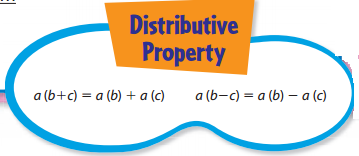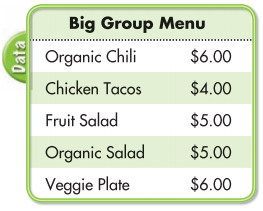Envision Math 6th Grade Textbook Answer Key Topic 2.4 The Distributive Property
The Distributive Property
How can you use the Distributive Property to evaluate expressions?
Answer:
The Distributive Property states that multiplying a sum (or difference) by a number gives the same result as multiplying each number in the sum
(or difference) by the number and adding (or subtracting) the products.

Guided Practice
Do you know HOW?
In 1 through 4, find each missing number.
Question 1.
8(7 + 23) = 8(7) + 8(☐)
Answer:
23
Explanation:
Question 2.
4(28) = 4(20) + 4 (☐)
Answer:
8
Explanation:
Question 3.
8(57) – 8(7) = 8(☐)
Answer:
50
Explanation:
Question 4.
5(26 – 3) = 5 (☐) – 5(3)
Answer:
26
Explanation:
Use mental math to evaluate 5 and 6.
Question 5.
6(32) = ☐
Answer:
192
Explanation:
Question 6.
20(5) – 20(2) = ☐
Answer:
60
Explanation:
Do you UNDERSTAND?
Question 7.
Why is it easier to evaluate 7 × 60 than to evaluate 7 × 55 + 7 × 5?
Answer:
See margin.
Explanation:
Question 8.
Tony read 22 pages in the morning and 28 pages in the afternoon for 5 days. Lois read 47 pages each day for 5 days. Explain howto use the Distributive Property to find how many pages each of them read.
Answer:
See margin.
Explanation:
Independent Practice
Leveled Practice In 9 through 16, find each missing number.
Question 9.
3(28) + (3)2 = ☐ (30)
Answer:
3
Explanation:
Question 10.
9(23) = 9(☐) + 9(3)
Answer:
20
Explanation:
Question 11.
6(46) – 6(6) = 6(☐)
Answer:
40
Explanation:
Question 12.
4(33) = 4(30) + 4(☐)
Answer:
3
Explanation:
Question 13.
30(22 – 10) = 30(22) – 30(☐)
Answer:
10
Explanation:
Question 14.
8(99) = 8(100) – 8(☐)
Answer:
1
Explanation:
Question 15.
20(33 – 5) = 20(☐)
Answer:
28
Explanation:
= 20(☐) + 20(8)
Answer:
20
Explanation:
Question 16.
5(42) + 5(5) = 5(☐)
Answer:
47
Explanation:
= 5(☐) + 5(7)
Answer:
40
Explanation:
Use the Distributive Property to break apart a number to find the product for 5 × 27.
5 × 27 ← Break 27 apart.
![]()
5(20) +5 (7) ← Multiply each addend.
100 + 35 ← Add.
135
5 × 27 = 135
Use the Distributive Property to join numbers together to find 8(32) – 8(2).
8(32) – 8(2)
8(32 — 2) ← Join factors.
8(30) ← Subtract.
240 ← Multiply.
8(32) – 8(2) = 240
Independent Practice
Use the Distributive Property and mental math to evaluate.
Tips: When doing mental math, choose to join or break apart based on which is easier.
Question 17.
7(29)
Answer:
203
Explanation:
Question 18.
6(21) + 6(31)
Answer:
312
Explanation:
Question 19.
5(22) + 5(8)
Answer:
150
Explanation:
Question 20.
8(47)
Answer:
376
Explanation:
Question 21.
6(41) + 6(9)
Answer:
300
Explanation:
Question 22.
30(3) + 30(5)
Answer:
240
Explanation:
Question 23.
3(21) – 3(11)
Answer:
30
Explanation:
Question 24.
5(25 – 3)
Answer:
110
Explanation:
Problem Solving
Question 25.
Writing to Explain The 6th graders ordered lunch from the Big Group Menu.They ordered 22 organic chilis and 8 veggie plates.Their order can be expressed as 6(22) + 6(8). Explain what mental math steps you would use to find the total cost of the order.

Answer:
See margin.
Question 26.
Using the Big Group Menu, write and solve a problem where you can use the Distributive Property.
Answer:
See margin.
Question 27.
Writing to Explain Jamal said that 9.45 is greater than 9.8 because 45 is greater than 8. Is he correct? Explain.
Answer:
No; sample answer: 0.8 = 0.80 and 80 > 45.
Explanation:
Question 28.
Hiroko put money in a savings account each week. After 9 weeks, there was $49.50 in the account. If Hiroko put the same amount in each week, how much did she save each week?

Answer:
$5.50
Explanation:
Question 29.
Think About the Process Which choice shows a problem with common factors that could be used for mental math?
A. 3(45) + 3(5)
B. 4(18) – 7(8)
C. 2(22) + 3(33)
D. 8(39) + 4(40)
Answer:
A. 3(45) + 3(5)
